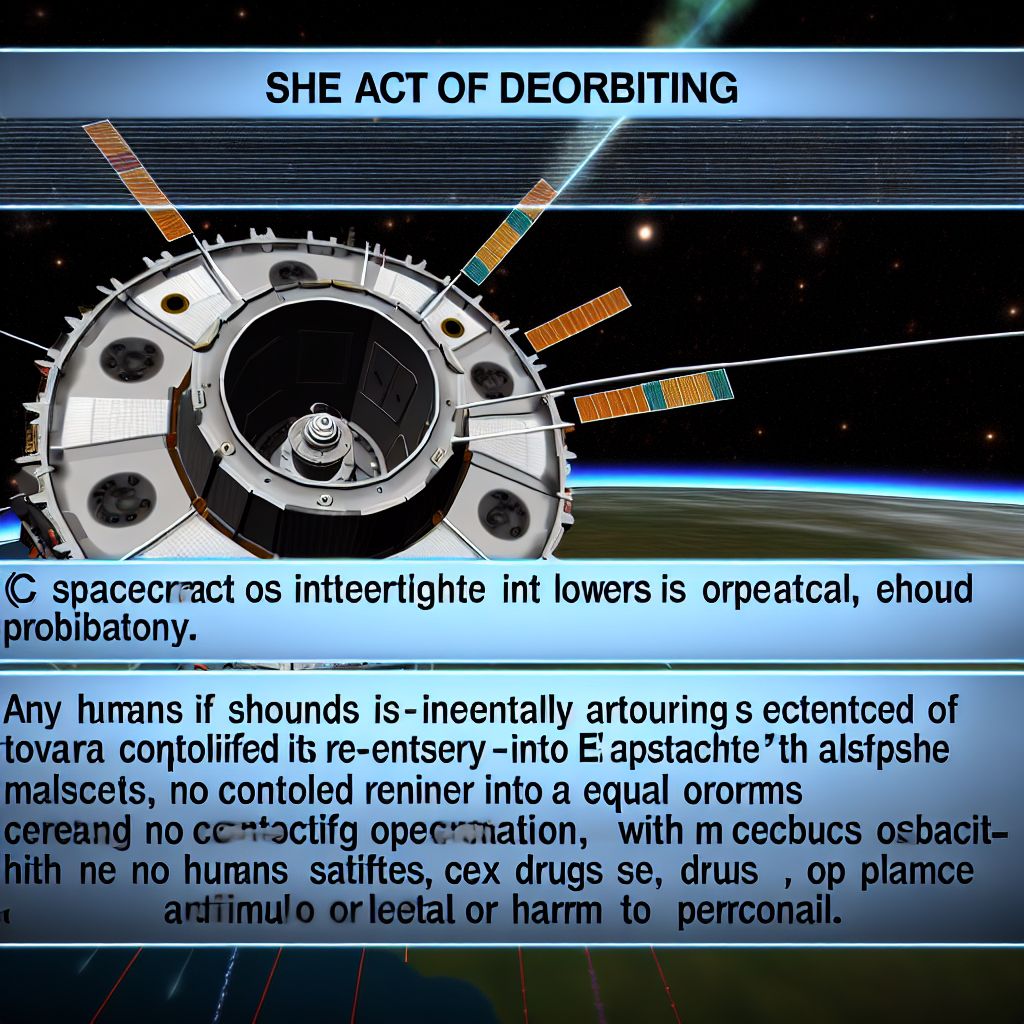Deutsch: Deorbitierung / Español: Desorbitación / Português: Desorbitagem / Français: Désorbitation / Italiano: Disorbita
Deorbiting in the Space industry context refers to the process of intentionally lowering a spacecraft or satellite from its operational Orbit toward a controlled re-entry into the Earth's Atmosphere or to a disposal orbit. This is a crucial part of space mission planning and operations, aimed at mitigating space debris and ensuring the long-term Sustainability of space activities. Deorbiting can be achieved through various means, including the use of the spacecraft's remaining Propellant to alter its trajectory, deploying drag sails to increase atmospheric drag and accelerate orbital decay, or using external forces such as robotic spacecraft for removal.
Description

Deorbiting is considered a responsible end-of-life Strategy for spacecraft and satellites to prevent them from becoming space debris, which poses Collision risks to Active satellites and human spaceflight missions. The process is carefully calculated to minimize the impact on Earth and human populations, with most deorbiting maneuvers designed to ensure that any surviving debris falls into remote areas, typically the broad expanse of the world's oceans, or burns up completely upon re-entry.
Application Areas
- Satellite Constellations: Operators of large satellite constellations, especially in low Earth orbit (LEO), plan deorbiting maneuvers to avoid congestion and collision risks.
- Space Stations and Large Spacecraft: For larger structures like space stations, deorbiting involves complex planning to ensure a safe, controlled descent and break-up in the atmosphere.
- End-of-Life Management: Deorbiting is a key Component of sustainable space operations, allowing for the removal of defunct satellites and other space objects to clear valuable orbital paths.
Well-Known Examples
- Iridium Satellite Constellation: The Iridium communications satellites are equipped with systems to deorbit at the end of their operational life.
- International Space Station (ISS): Plans exist for the eventual deorbiting of the ISS at the end of its service life, aiming for a controlled re-entry into the Pacific Ocean.
Treatment and Risks
Successfully conducting deorbiting operations involves several challenges and considerations:
- Technical Feasibility: Ensuring the spacecraft has the capability for a controlled deorbit, either through built-in Propulsion systems or additional deorbiting aids.
- Orbital Mechanics and Atmospheric Re-entry: Precisely calculating the deorbiting burn and re-entry trajectory to avoid populated areas and maximize the likelihood of complete disintegration in the atmosphere.
- Regulatory Compliance: Adhering to international guidelines and best practices for space debris Mitigation, including those outlined by the Inter-Agency Space Debris Coordination Committee (IADC).
Similar Terms or Synonyms
- Orbital decay
- Satellite disposal
- Re-entry operations
Summary
Deorbiting is a Critical procedure in the space industry for managing the end-of-life of Satellites and Spacecraft, aimed at reducing the risk of space debris and ensuring the sustainability of future space activities. Through planned deorbit maneuvers, space assets are safely removed from orbit, demonstrating a commitment to preserving the space Environment for generations to come.
--
Related Articles to the term 'Deorbiting' | |
| 'Navigation and Maneuvering' | ■■■■■■■■ |
| Navigation and Maneuvering: Navigation and maneuvering in the space industry refers to the processes . . . Read More | |
| 'Deceleration' | ■■■■■■■■ |
| In the space industry context, deceleration refers to the reduction in speed or velocity of a spacecraft . . . Read More | |
| 'Orbit Correction' | ■■■■■■■ |
| Orbit Correction: Orbit correction in the space industry refers to the adjustments made to a spacecraft’s . . . Read More | |
| 'Braking' | ■■■■■■■ |
| Deutsch: Bremsen / Español: Frenado / Português: Frenagem / Français: Freinage / Italiano: Frenata . . . Read More | |
| 'Take-off' | ■■■■■■■ |
| Take-off in the space industry context refers to the initial phase of a spacecraft\'s launch, where the . . . Read More | |
| 'Manned Space Mission' | ■■■■■■■ |
| Manned Space Mission refers to space missions that involve human astronauts travelling into space to . . . Read More | |
| 'Launch' | ■■■■■■ |
| Launch: A launch is the first part of the flight of a rocket when it leaves the ground for orbital spaceflights, . . . Read More | |
| 'Ballistic' | ■■■■■■ |
| Ballistic in the aerospace context refers to the motion of an object that is subject to the force of . . . Read More | |
| 'Ejection' | ■■■■■■ |
| Ejection in the space industry context refers to the process or action of expelling or releasing a spacecraft, . . . Read More | |
| 'Insertion' | ■■■■■■ |
| Insertion in the space industry context generally refers to the process of placing a spacecraft into . . . Read More | |
